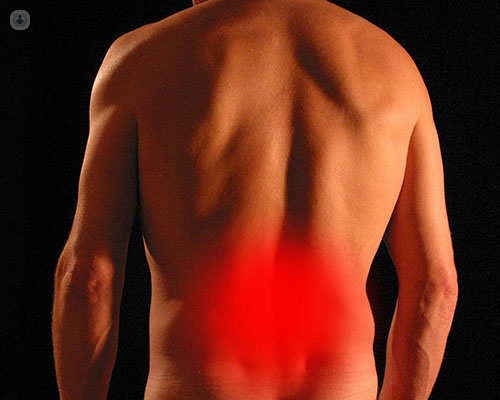An expert's guide to sciatica
Written in association with:Sciatica is a painful condition in which the nerves in the spine become compressed, sometimes requiring surgery. In our latest article, renowned consultant spinal surgeon Mr Awaiz Ahmed gives his expert insight into this condition, including its causes and treatment.
What is sciatica and how is it diagnosed?
Sciatica is a compression of the nerve as it leaves the lower back and enters the legs or the rest of the body. There are various reasons the nerve could become compressed. It could be a disc prolapse, arthritis, a condition called stenosis, an injury, a tumour, or an infection. People suffering from sciatica experience pain along the nerve, which usually radiates into the buttocks, the back of the thigh and towards the foot.

Is sciatica ever considered to be a medical emergency?
Yes, at times sciatica can present with a condition called cauda equina syndrome, which means horsetail in Latin. It has this name because as the nerves come out of the spine they are in a bunch and resemble a horsetail. These nerves are quite sensitive if pressure is put on them. If they experience a sudden onset of pressure, probably because of disregard which is the most common cause, the patients can lose control of their bowel or bladder, see a change in sexual function, and have a loss of feeling in the private area. This is an emergency and the surgery to decompress the nerves has to be done as soon as possible. If there is a delay in the surgery then the damage can be irreversible.
Can sciatica be treated non-surgically?
Yes. Most cases of sciatica are treated non-surgically. I would say 85 to 90 per cent of patients do not require surgery. The treatment usually involves nerve tablets which can help calm the nerve, physiotherapy, and anti-inflammatories. It normally takes about four to six weeks for the symptoms to settle down. If the symptoms do not settle after this and the patient has a significant amount of pain, then the second step is to offer them spine injections, in the form of nerve root blocks. I use steroid and local anaesthetic, which is injected around the nerve to block it. It reduces any inflammation because of pressure, and this can be another way of trying to control sciatica without necessarily going down the surgical route.
How can sciatica be prevented?
The most important advice is for patients to keep the core strong. The core is made up of the muscles in your back, your abdomen, and the oblique muscles, which are on the side of your abdomen. These muscles need to be kept conditioned and strong. Patients are advised to avoid putting on weight and to stop smoking. These are some of the ways that modification of your lifestyle can help prevent sciatica.

Once sciatica is set, then my advice to patients is to avoid lifting heavy objects. If you have to lift heavy objects as part of your profession, some precautions are normally taught to the patients by their physiotherapists. There are ways of lifting, and getting some assistance and aids, which can help prevent the onset of this condition
What is the main difference between sciatica and scoliosis?
These are two completely different conditions. Sciatica is common terminology used for pain down the nerve, which can be due to various reasons. As I’ve mentioned, it could be because of a prolapsed disc, arthritis, a tumour, an injury or infection.
In contrast, scoliosis is a deformity of the spine, where the spine does not have its normal alignment. Usually, the spine has an “S” shape. Scoliosis normally happens when you lose the alignment of the bones which form the spine, and they start to rotate. There are many reasons this could happen. It could be something people are born with, called congenital scoliosis, where part of the bone forms abnormally.
Sometimes, when we reach puberty and go through a growth spurt, some parts of the spinal bone grow faster than other parts. The bone then starts to twist so you get a kind of a curve in the spine, making you look like you have a hump which is more obvious on one side. There is also a mismatch between the shoulders.
Lastly, scoliosis can develop because of injuries, or wear and tear in the spine later in life.
Mr Awaiz Ahmed is a leading London-based consultant spinal surgeon. If you have any concerns regarding your spine, or suffer from back pain, please don’t hesitate to book a consultation with Mr Ahmed via his Top Doctors profile today.


